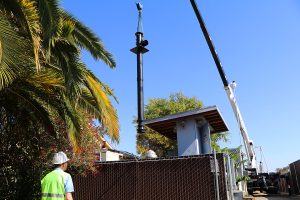For Immediate Release –
Marin County, CA –
Rainy season preparedness is crucial for County staff and Marin’s residents alike

Winter storms can cause significant damage to public and private property, especially when coupled with seasonal high tides or once the ground has become saturated with water later in the season from prior rains. Whenever a storm is forecast, it is critical that residents and agencies prepare for it, regardless of whether or not it is an El Niño year.
Every year, Marin County Department of Public Works (DPW) and Marin County Flood Control & Water Conservation District (District) staff wrap up storm season preparations by October on public property in Marin. However, the staff still conducts inspections and any necessary maintenance work prior to each forecasted storm. Including assets overseen by DPW and District, the staff oversees more than 420 miles of roadway, hundreds of culverts, 18 pumps stations with a total of 52 pumps, 37 miles of creek beds, 200 flow gates, 14 miles of levees, over a mile of floodwalls, 70 trash racks, and three major flood detention basins.
When a storm is forecast by the National Weather Service[External], DPW and District staff check various flood mitigation facilities to ensure they are functional and clear of debris. If the storm is predicted to be significant, the staff are scheduled to work around the clock during the storm to address needs in the field as they arise. Immediately following a significant storm, crews are sent out to assess damages, conduct maintenance, ensure public safety, and begin planning and preparations for the next potential storm.
For residents, it is strongly encouraged to take action on their own property to help reduce the risk of flooding on their land, which can also impact their neighbor’s property. Before a storm, it is recommended that residents clear dead leaves from their driveway drains, rooftop gutters, and storm drains. Foliage should be disposed of in compost bins, not left in street gutters where it will clog drainage systems and cause neighborhood flooding. It is also important to remove any obstructions approaching driveways or placed in street gutters, such as rubber ramps which can block street gutters and exacerbate localized flooding.
Seasonal high tides, sometimes referred to as king tides, can exacerbate localized flooding in coastal and bayside communities. It is important for residents to be aware of when those tides occur so that travel and commute plans can be adjusted. In advance of high tides and storm events, people living in flood-prone areas should test their sump pumps and stock up on sandbags (available at most local hardware stores). Learning how to properly use sandbags[External] is a critical component to flood preparedness and should be done prior to storms.
It is highly recommended that residents sign up for the AlertMarin in order to receive potentially life-saving instruction. The service, managed by the Marin County Office of Emergency Management, provides time-sensitive emergency notifications to areas identified within the danger zone. Residents who have registered are asked to review their contact information ahead of the flood season to ensure it is up to date. For information on how to get prepared, including emergency “go-bag” packing checklists, visit ReadyMarin.org[External].
Flood insurance is important for homeowners and renters alike, since standard insurance policies do not usually include flood damage. Even a few inches of water can result in thousands of dollars in repair and restoration costs. Marin County participates in the National Flood Insurance Program[External], which makes federally backed insurance[External] available for all homes, and provides a range of resources[External] to help property owners make the best decisions. Residents who seek such coverage are encouraged to contact their respective insurance agency and be aware that it takes time to process an addition such as this to your policy.
For additional information prior to a storm, residents can call DPW at 415-473-6530 during normal business hours. Residents of unincorporated areas of Marin can also call DPW during a storm to be routed to the respective County of Marin department that can address their concerns. Additionally, the DPW website has a Report an Issue portal that can be used to submit problems or concerns which will be handled outside of an active storm event. Residents living in the incorporated towns and cities of Marin should find out which agency’s jurisdiction their area falls under so that they reach the best contact possible when there is a need. During a storm event, residents should utilize the Marin County Emergency Portal of assistance, resources and information. However, when there is an immanent threat to life or property, residents should call 911.
Contact:
Rosemarie Gaglione
Director
Public Works
3501 Civic Center Drive.
#304
San Rafael, CA 94903
